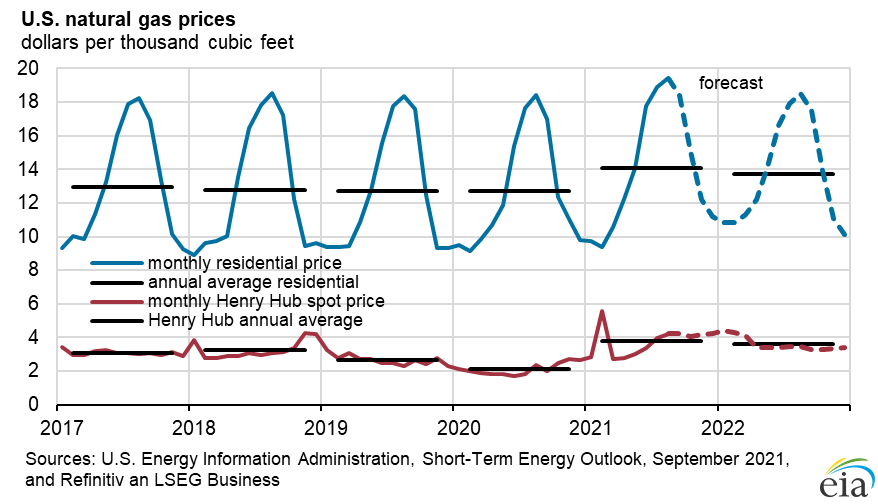EIA Expects Higher Natural Gas Prices Due to Production Reductions Following Hurricane Ida
The U.S. Energy Information Administration expects that natural gas prices will remain higher in the coming months following Hurricane Ida.
In its September Short-Term Energy Outlook (STEO), EIA forecast fourth-quarter Henry Hub spot prices to average $4.00 per million British thermal units (MMBtu), a 16% increase from its August forecast.
EIA also revised its 2022 forecast of the average U.S. natural gas price to $3.47/MMBtu, a 13% increase over its previous forecast.
“Hurricane Ida affected natural gas production at a time that the United States was already experiencing higher natural gas prices due to growth in exports, strong domestic natural gas consumption, and relatively flat natural gas production,” said EIA Acting Administrator Steve Nalley. “Lost production from the storm combined with these current market conditions has limited our ability to build up natural gas inventories, and we expect that will keep prices higher in the short term than we had previously thought.”
Hurricane Ida led producers to close more than 90% of natural gas and crude oil production capacity in the Gulf of Mexico region as the storm approached. Significant production and refining capacity remains offline in the region. EIA expects that production and refining activity will gradually be brought back online through September.
U.S. natural gas prices ended August at $4.33/MMBtu, bringing the monthly average to $4.07/MMBtu, a 77% increase over August 2020.
Also in the STEO:
- Brent crude oil prices averaged $71 per barrel in August, down $4 per barrel from July, but up $26 per barrel over August 2020. EIA expects Brent crude oil to average $71 for the fourth quarter of 2021 and $66 in 2022.
- EIA forecasts small-scale solar capacity—primarily from residential rooftop solar panels—to increase by more than 11.5 gigawatts (GW) in 2021 and 2022. Small-scale solar capacity increased by 4.5 GW in 2020.
- EIA estimates that U.S. energy-related carbon dioxide (CO2) emissions decreased by 11% in 2020 because of less energy consumption related to reduced economic activity and responses to COVID-19. For 2021, it forecasts energy-related CO2 emissions will increase about 8% from the 2020 level as economic activity increases and leads to rising energy use. EIA expects energy-related CO2 emissions to rise in 2022 but at a slower rate of 2%.
Related News
Related News

- Kinder Morgan Proposes 290-Mile Gas Pipeline Expansion Spanning Three States
- Three Killed, Two Injured in Accident at LNG Construction Site in Texas
- Tallgrass to Build New Permian-to-Rockies Pipeline, Targets 2028 Startup with 2.4 Bcf Capacity
- TC Energy Approves $900 Million Northwoods Pipeline Expansion for U.S. Midwest
- U.S. Moves to Block Enterprise Products’ Exports to China Over Security Risk
- U.S. Pipeline Expansion to Add 99 Bcf/d, Mostly for LNG Export, Report Finds
- Enbridge Adds Turboexpanders at Pipeline Sites to Power Data Centers in Canada, Pennsylvania
- Great Basin Gas Expansion Draws Strong Shipper Demand in Northern Nevada
- Cheniere Seeks FERC Approval to Expand Sabine Pass LNG Facility
- Heath Consultants Exits Locate Business to Expand Methane Leak Detection Portfolio





Comments